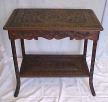 | Caithness.Org | Community | Business | Entertainment | Caithness... | Tourist Info | Site Map |
• Advertising • Chat Room • Contact Us • Kids Links • Links • Messageboard • News - Local & Scottish • News - UK & News Links • About / Contact Us • Submissions |
• Bookshop • Business Index & News • Jobs • Property For Sale • Property For Rent • Shop • Sutherland Business Index |
• Fishing • Fun Stuff • George, The Saga • Horses • Local Galas • Music • Pub Guide • Sport Index • What's On In Caithness |
• General Information • B & Bs • Backpackers • Caravan & Camping • Ferries • Getting Here • Holiday Letting • Hotels • Orkney • Pentland Firth • Sutherland • Taxis |
| N E W S F E E D S >>> |
Chip-Carving In Caithness
|
McIvor and Allan, Chip Carvers of Castletown c.1890
to c.1955 |
|
The original version of this account was researched and compiled for personal reasons and on behalf of the Castletown Heritage society which staged an exhibition of the firm's products during the Spring/Summer of 2001. Enquiries had, of necessity to be curtailed in order to meet the timetable proposed by the Society, but at the time of producing the provisional account, many matters still had to be investigated. After the exhibition closed, with more time available for research, it has become possible to fill out the picture to a greater extent by following up further lines of enquiry.
It is natural that for many centuries past. particularly in well-forested countries, when outdoors work was impossible, people would spend some time making and decorating wooden articles of many kinds for everyday use, or for sale, only a few of which, by their nature, would have survived until the present day, except in museums.
A researcher at University of St Andrews has stated that chip-carving small items, such as boxes, small trays, and so on, was a widespread and popular activity among ladies of leisure in the towns and cities of Central/Southern Scotland towards the end of the 19th Century, but this seems to have declined during the Edwardian era and doubtless largely died out during the First world War. This evidence helps to explain the otherwise rather surprising, almost improbable statement quoted later in this paper, relating how it was that John McIvor was taught to be the expert chip-carver he subsequently became.
As far as is known, no-one still alive has knowledge of how the patterns used by the firm came into its possession, nor was there left a record of this when the firm finally ceased to exist, but not only the chip-carved patterns but also the form of some of the furniture (e.g., the "Moroccan" stools/tables) have their counterpart in Indian furniture. To uncover the underlying reasons why, apparently without a local tradition of such work the turn of the 20th Century, prospering until the Second World War, before finally closing down in the mid 1950's, has been a fascinating task. Many people living in Caithness, or who have their roots in the county, have contributed greatly to the creation of this brief history. The search for hard facts and for the background of the two founders of the firm, has brought to light just how many superb examples of the products of this firm still survive, to be treasured by their owners. The 2001 Exhibition of the Castletown Heritage Centre will have reminded people of their history and importance of their possessions and a renewed interest in chip-carving has been awakened. It is perhaps relevant to explain that the genesis of this enquiry was a desire to find out more about a table left to the writer by a very old Scottish lady, but the property, in 1900, of her mother who took it to Brazil, whence it returned to Scotland in 1937. The now sizeable collection of letters and documents acquired during the investigation will, eventually be passed either to the County Archives, or to the Heritage Society. Page Two of McIvor & Allan Chip-carvers Calder Carvings continue the tradition today in a direct line from the famous firm. |












